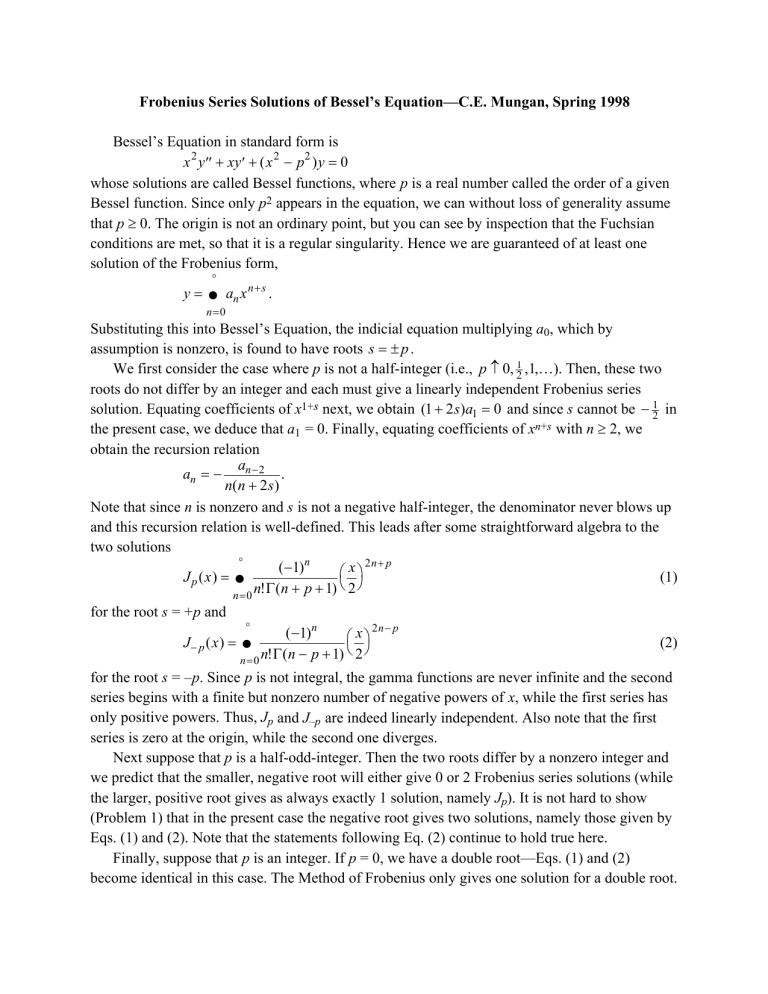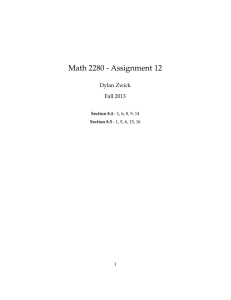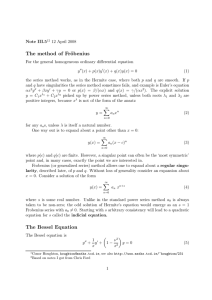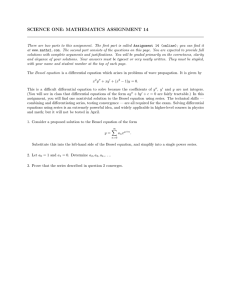Frobenius Series Solutions of Bessel’s Equation—C.E. Mungan, Spring 1998 0 (

Frobenius Series Solutions of Bessel’s Equation—C.E. Mungan, Spring 1998
Bessel’s Equation in standard form is x y
′′ + ′ +
( x
2 − p
2
) y
=
0 whose solutions are called Bessel functions, where p is a real number called the order of a given
Bessel function. Since only p 2 appears in the equation, we can without loss of generality assume that p
≥
0. The origin is not an ordinary point, but you can see by inspection that the Fuchsian conditions are met, so that it is a regular singularity. Hence we are guaranteed of at least one solution of the Frobenius form,
∞ y
= ∑ n
=
0
.
Substituting this into Bessel’s Equation, the indicial equation multiplying a
0
, which by assumption is nonzero, is found to have roots s
= ± p .
We first consider the case where p is not a half-integer (i.e., p
≠
0
1
1
K
). Then, these two roots do not differ by an integer and each must give a linearly independent Frobenius series solution. Equating coefficients of x the present case, we deduce that a
1+ s next, we obtain ( )
1
=
0 and since s cannot be
− 1
2
1
= 0. Finally, equating coefficients of x n+s with n
≥
2, we
in obtain the recursion relation a n
= −
( a n
+
−
2
2 s )
.
Note that since n is nonzero and s is not a negative half-integer, the denominator never blows up and this recursion relation is well-defined. This leads after some straightforward algebra to the two solutions
J p
( )
=
∞
∑ n
=
0
(
−
1 ) n n
Γ n
+ +
1 ) 2 x
2
(1) for the root s = +p and
J − p
( )
= n
∞
∑
=
0
(
−
1 ) n x n n p 1 ) 2
2 n p
(2) for the root s = –p. Since p is not integral, the gamma functions are never infinite and the second series begins with a finite but nonzero number of negative powers of x, while the first series has only positive powers. Thus, J p
and J
–p
are indeed linearly independent. Also note that the first series is zero at the origin, while the second one diverges.
Next suppose that p is a half-odd-integer. Then the two roots differ by a nonzero integer and we predict that the smaller, negative root will either give 0 or 2 Frobenius series solutions (while the larger, positive root gives as always exactly 1 solution, namely J p
). It is not hard to show
(Problem 1) that in the present case the negative root gives two solutions, namely those given by
Eqs. (1) and (2). Note that the statements following Eq. (2) continue to hold true here.
Finally, suppose that p is an integer. If p = 0, we have a double root—Eqs. (1) and (2) become identical in this case. The Method of Frobenius only gives one solution for a double root.
If p is a positive integer, then the two roots differ by a nonzero integer and the smaller root again must either give 0 or 2 Frobenius series solutions. Unlike the half-odd-integer case, however, this time the smaller root fails to give any solutions (Problem 2). The larger, positive index gives one solution, namely that given by Eq. (1). Notice that the coefficients of this series are never zero nor infinite and we have no negative powers of x, so that this series remains well-behaved, as well as finite at the origin.
Equation (1) is thus a solution of Bessel’s Equation for any order and it is always finite at the origin. We therefore take it to be the standard form for one of the linearly independent solutions and call it the set of Bessel functions of the first kind. It is unsatisfactory to take Eq. (2) as our second solution in general, however, because it is not linearly independent of Eq. (1) if p is an integer (Problem 3). Instead we take the following combination,
Y x
=
N p x
= n
→ p
[ π
) ( )
− csc(
π n J − n x
]
.
(3)
If p is not an integer, then neither the cotangent nor the cosecant is ever infinite, so that the limit reduces to
( )
=
N p x
= cot(
π p J p x
− csc(
π p J − p x .
(4a)
Furthermore, in such cases the cosecant is never zero, so that this combination is linearly independent of Eq. (1). In fact, if p is a half-odd-integer, then Y p
= ±J
–p
(Problem 4). Notice that because of the J
–p
contribution, Y p
diverges at the origin.
If p is an integer, then Eq. (3) is of the indefinite form 0/0 and we apply L’Hôpital’s Rule to obtain
( )
=
N p
( )
=
1
π
dJ p
( ) dp
( 1 ) p dJ − p
( ) dp
.
(4b)
It can be shown that the right-hand side of this equation is well-behaved at integral values of p and that it is linearly independent of J p
. In fact, it is equivalent to the second solution of Bessel’s
Equation obtained for integral p by substituting the trial form
∞
( )
=
J p
( ) ln x
+ ∑
.
n
=
0
Owing to the logarithm, this solution diverges to –
∞
at the origin. Putting p
→
–p again merely
(5) gives this same solution, to within sign (Problem 5).
Thus, Eqs. (4) give a second, linearly independent solution to Bessel’s Equation, which is called the set of Bessel functions of the second kind, also known as Weber or Neumann functions. They diverge at the origin and hence are not physically allowable in applications where a finite solution is required at that location.
Problems
1. Let p be the half-odd-integer ( 2 m
+
) / , where m is a non-negative integer. Prove that the smaller index s = –p gives both of the series solutions (1) and (2) by repeating the Method of
Frobenius and carefully considering all possibilities when you equate coefficients for n = 1 and for n
≥
2.
2. Let p be a positive integer. Prove that putting the smaller index s = –p into the recursion relation leads to the fact that a
0
= 0, so that the Method of Frobenius fails to give a solution for
Hint : Rewrite the recursion relation by solving for a
n–2
rather than a n
and work downwards in values of n starting from some judiciously chosen value.
3. Boas problem #12.13.2—This proves that J p
and J
–p
are not linearly independent if p is an integer.
( ) ( 1 ) p
+
J − p
( ) if p is a half-odd-integer.
5. Prove that Y − p x
= −
1 ) p
Y x





